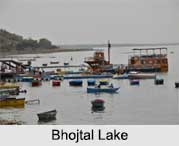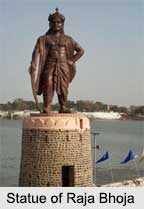 Tourism in Bhojtal Lake includes the natural beauty of the lake, bird sanctuary and the religious and archaeological significances. Bhojtal Lake also serves as a major source of drinking water for the residents of the Bhopal city. This lake is serving around 40 percent of the inhabitants of Bhopal.
Tourism in Bhojtal Lake includes the natural beauty of the lake, bird sanctuary and the religious and archaeological significances. Bhojtal Lake also serves as a major source of drinking water for the residents of the Bhopal city. This lake is serving around 40 percent of the inhabitants of Bhopal.
People of Bhopal, Madhya Pradesh are religiously and culturally attached to the lake of Bhojtal. Bhojtal Lake meets the needs of water supply for irrigation and drinking purpose. It also acts as an irrigational water supply plant to cultivate chestnut in Bhojtal. It is better known as "Chhota Talaab" which means small lake. It is a magnificent lake of 11th century known as one of the oldest man-made lakes in India. Bhojtal Lake is a large lake which lies on the western side of the capital city of Madhya Pradesh, Bhopal.
History of Bhojtal Lake
According to the neighbouring myths, Bhojtal Lake is said to have been built by the Paramara Raja Bhoja during his term as a king of Malwa (1005-1055). There is a legend why they built the lake. Once king Bhoja suffered from skin disease and all doctors failed to make well him. Then, one day a saint told the king to build a tank to join 365 tributaries and then have a bath in it to wipe out the skin ailment. Bhoja called upon his engineers to build up a huge tank. They saw a place near Betwa River, which was 32 kilometres away from Bhopal. It was found that it has only 359 tributaries. A Gond Commander Kalia pleased this shortage. He then gave the address of an unseen river. After merging the tributaries of this river the number 365 was completed. The lake was created by constructing a clay dam across the Kolans River. An eleven gate dam called the Bhadbhada dam was constructed at Bhadbhada in 1965 at the southeast corner of the Lake, and now manages the leak to the river Kaliasote.
The lake was recognized as the "Upper Lake" or "Bada Talab" ("Big Pond") until March 2011. It was renamed to Bhojtaal in honour of the Great King Raja Bhoja. A huge statue of Raja Bhoja, standing with sword, was also installed on a pillar on one corner of the lake to cement the name of Bhopal as the city of lakes.
Geography of Bhojtal Lake
Bhojtal is situated on the west central part of Bhopal city and is surrounded by Van Vihar National Park on the south, human settlements on the east and north, and agriculture fields on the west. It has an area of 31 kilometres. The watershed of the Upper Lake is chiefly rural, with some urbanized areas around its eastern end. The Kolans was formerly a tributary of the Halali River, but with the creation of the lake using an earthen dam and a diversion channel, the upper reach of the Kolans River and Bada Talaab now drain into the Kaliasote River.
Things to do in Bhojtal Lake
Bhojtal Lake attracts a large number of national and international tourists due to its scenic beauty. National Sailing Club is the first sailing club of India that has been established on the eastern side of Bhojtal Lake. Bhojtal Lake offers various water sports such as kayaking, canoeing, rafting, water skiing, parasailing to the tourists as this spot serves as eco-tourism site in Madhya Pradesh.
Another attraction of Bhojtal Lake is Van Vihar National Park. Van Vihar National Park in Bhopal is situated on the south-eastern side of the lake. There are about 207 species of birds, 60 species of butterfly; animals like Royal Bengal Tiger, leopard, hyena, Sloth bear, lion, sambar, chital, etc. are also present at the park along with gharial, crocodile and several species of tortoise. The road passing through it has on one side the animals in their natural habitats, and on the other hand is the scenic beauty of Bhojtal Lake.
Bhojtal Lake is also the abode of various birds. Some of the birds are migratory and some are local. Some of the birds are common in Bhojtal Lake namely, White stork, black-necked stork, barheaded goose, spoonbill etc. The cranes are in major population in Bhojtal Lake. The idols of Hindu Gods and Goddesses near the temples of Bhojtal Lake are also immersed in the lake during the regional religious festivals. The Takia Island in Bhojtal Lake, which is also known as Upper Lake has a burial place of the Shah Ali Shah Rahamatullah Alla, which has religious and archaeological significance.
Visiting Information of Bhojtal Lake
Bhojtal Lake is well connected with the other places of the country. Nearest railway station of Bhojtal Lake is Bhopal Railway station. Nearest Airport is Raja Bhoj Airport or Bhopal International Airport.



















